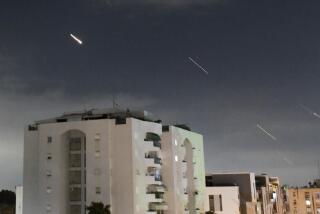Baghdad’s Sudden Interest in Peace Is No Surprise : Tactics: Hussein must realize, however, that in this war, the U.S. is dictating terms by going on the offensive, not the defensive.
- Share via
Why the sudden Iraqi interest in peace? One reason may have been the rumors sweeping Washington that the allied ground attack was imminent. Already badly mauled by the continuing air assault, which has cost him 1,300 of his 4,280 tanks and 1,100 of his 3,110 artillery pieces, Saddam Hussein knew that such an attack would be decisive.
Like the North Vietnamese, who held out the promise of peace talks and clamored for a cease-fire each time they got in trouble militarily, the Iraqi president evidently thought he could buy time to give his combat forces a breather, re-establish his severely damaged lines of command and control and resupply his front-line forces.
But the United States didn’t bite. “If he was trying to get a military advantage out of it,” said Lt. Gen. Thomas W. Kelly, director of operations for the Joint Chiefs of Staff, in a Pentagon briefing Friday, “he failed utterly.” The bombing campaign continues unabated, and preparations for the ground offensive proceed apace.
Although Hussein doesn’t seem to realize it, the war in the Persian Gulf is not the Vietnam War, and nowhere is that more true than when it comes to the military principle of attack.
This is a key principle of war. As FM 100-5, the Army’s war-fighting manual, emphasizes: “Offensive action . . . permits the political leader or the military commander to capitalize on the initiative, impose his will on the enemy, set the terms and select the place of confrontation or battle, exploit vulnerabilities and react to rapidly changing situations and unexpected developments.”
At the strategic level, the war in the Gulf is the first time this principle has come into play for the United States since World War II. Both the Korean War and the Vietnam War were fought not on the strategic offensive but the strategic defensive. The initiative in both cases was surrendered to the enemy, and the best battlefield result obtainable was stalemate.
When the Chinese intervened in the Korean War in November, 1950, U.S. national policy changed from rollback and liberation--the way America had fought most of its previous wars--to containment. It was a policy driven by the realities of the Cold War. The fear was that continued ground offensive actions against North Korea would bring the Soviet Union into the war and escalate the conflict to the nuclear level. The same fears continued in the Vietnam War as well.
The result was that there were major restrictions in both wars on the application of American military power. But the Cold War is over, and those restrictions no longer apply.
At the operational, or theater-of-war, level in both the Korean and Vietnam wars, U.S. fear of escalation allowed the enemy to establish sanctuaries where it was free from attack. During the Korean War, enemy supply depots, staging areas and airfields just north of the Korean border in Manchuria were off limits to allied bombers. Chinese MIG-15 fighters from those bases would routinely attack allied planes, then flee to safety back across the border.
During the Vietnam War, the North Vietnamese had sanctuaries in China and, for much of the conflict, in Laos and Cambodia as well. For years, crazy as it may sound to some, their airfields were immune from attack for fear that Soviet technicians working there might be injured. And their major seaport of Haiphong, where 85% of their war materiel was received, was not closed until 1972, eight years after the U.S entry into the war.
Those kinds of restrictions were what President Bush was referring to when he pledged that the United States would not fight the war in the Gulf with one hand tied behind its back. And so far that pledge has been honored. All of Iraq’s neighbors have agreed to the sanctions imposed by the United Nations, and the flow of war materiel has been halted. And they have refused to allow sanctuaries as well. Iran, for example, has pledged that the Iraqi aircraft that have fled within its borders will be impounded for the duration.
But the biggest difference is on the ground. Although offensive air operations were carried out over North Vietnam (albeit with major restrictions on what could be hit) and from time to time the U.S. Navy shelled the enemy coast, ground combat operations against the enemy homeland were ruled out from the start. As a result, with no need to retain a reserve to provide for rear-area security, North Vietnam could and did send all its combat divisions to fight in the south.
Yet Iraq not only has to face an air threat to its survival, but it has to face a ground threat as well. And as was the case in World War II, this ground offensive will prove decisive.
More to Read
Sign up for Essential California
The most important California stories and recommendations in your inbox every morning.
You may occasionally receive promotional content from the Los Angeles Times.













